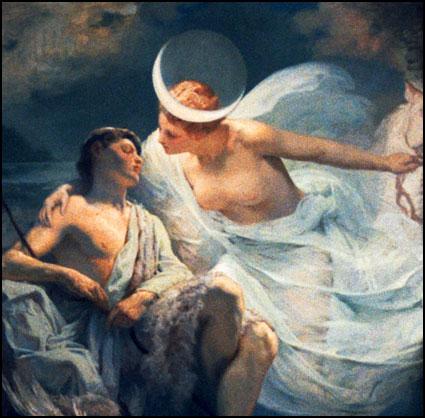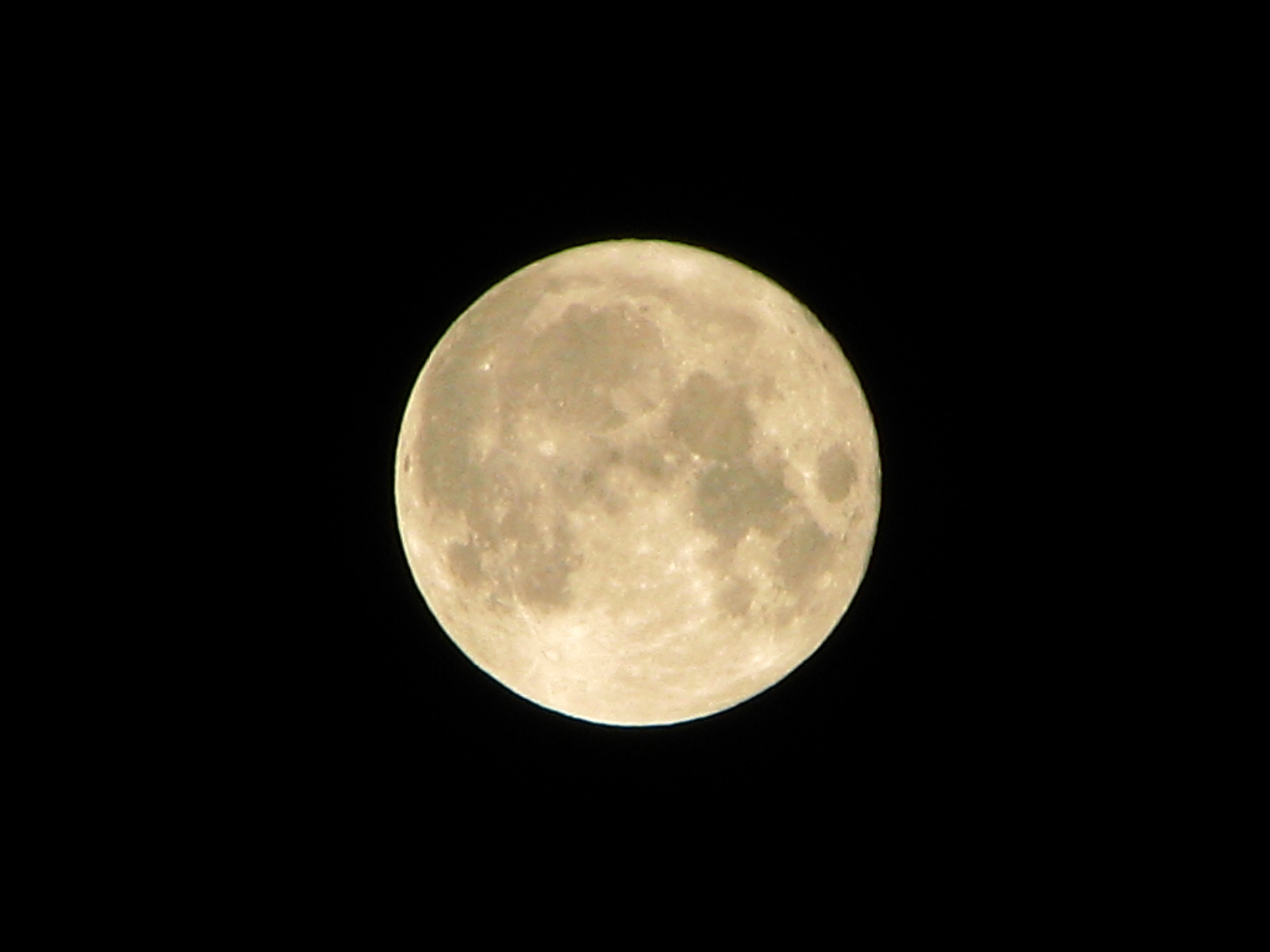|
Lunar Deity
A lunar deity or moon deity is a deity who represents the Moon, or an aspect of it. These deities can have a variety of functions and traditions depending upon the culture, but they are often related. Lunar deities and Moon worship can be found throughout most of recorded history in various forms. Moon in religion and mythology Many cultures have implicitly linked the 29.5-day lunar cycle to women's menstrual cycles, as evident in the shared linguistic roots of "menstruation" and "moon" words in multiple Language family, language families. This identification was not universal, as demonstrated by the fact that not all moon deities are female. Still, many well-known mythologies feature moon goddesses, including the Greek goddess Selene, the Roman goddess Luna (mythology), Luna, the Chinese goddess Chang'e, and the Mayan goddess Coyolxauhqu, who's decapitation may represent a lunar eclipse. Several goddesses including Artemis, Hecate, and Isis did not originally have lunar aspec ... [...More Info...] [...Related Items...] OR: [Wikipedia] [Google] [Baidu] |
Selene And Endymion
In ancient Greek mythology and Ancient Greek religion, religion, Selene (; , meaning "Moon")''A Greek–English Lexicon's.v. σελήνη is the goddess and personification of the Moon. Also known as Mene (), she is traditionally the daughter of the Titans Hyperion (Titan), Hyperion and Theia, and sister of the Solar deity, sun god Helios and the Dawn deities, dawn goddess Eos. She drives her moon chariot across the heavens. Several lovers are attributed to her in various myths, including Zeus, Pan (god), Pan, and the mortal Endymion (mythology), Endymion. In post-classical times, Selene was often identified with Artemis, much as her brother, Helios, was identified with Apollo. Selene and Artemis were also associated with Hecate and all three were regarded as lunar deity, moon and lunar goddesses, but only Selene was regarded as the personification of the Moon itself. Her equivalent in Roman religion and mythology is the goddess Luna (goddess), Luna. Etymology and origins ... [...More Info...] [...Related Items...] OR: [Wikipedia] [Google] [Baidu] |
Proto-Indo-European Mythology
Proto-Indo-European mythology is the body of myths and deities associated with the Proto-Indo-Europeans, speakers of the hypothesized Proto-Indo-European language. Although the mythological motifs are not directly attested – since Proto-Indo-European speakers lived in preliterate societies – scholars of comparative mythology have reconstructed details from inherited similarities in mythological concepts found in Indo-European languages, based on the assumption that parts of the Proto-Indo-Europeans' original belief systems survived in the daughter traditions. The Proto-Indo-European Pantheon (religion), pantheon includes a number of securely reconstructed deities, since they are both cognates—linguistic siblings from a common origin—and associated with similar attributes and body of myths: such as , the Sky deity, daylight-sky god; his consort , the Mother goddess, earth mother; his daughter , the dawn goddess; his sons the divine twins, Divine Twins; and and , a sola ... [...More Info...] [...Related Items...] OR: [Wikipedia] [Google] [Baidu] |
Proto-Indo-European Religion
Proto-Indo-European mythology is the body of myths and deities associated with the Proto-Indo-Europeans, speakers of the hypothesized Proto-Indo-European language. Although the mythological motifs are not directly attested – since Proto-Indo-European speakers lived in preliterate societies – scholars of comparative mythology have reconstructed details from inherited similarities in mythological concepts found in Indo-European languages, based on the assumption that parts of the Proto-Indo-Europeans' original belief systems survived in the daughter traditions. The Proto-Indo-European pantheon includes a number of securely reconstructed deities, since they are both cognates—linguistic siblings from a common origin—and associated with similar attributes and body of myths: such as , the daylight-sky god; his consort , the earth mother; his daughter , the dawn goddess; his sons the Divine Twins; and and , a solar deity and moon deity, respectively. Some deities, ... [...More Info...] [...Related Items...] OR: [Wikipedia] [Google] [Baidu] |
Chandra
Chandra (), also known as Soma (), is the Hindu god of the Moon, and is associated with the night, plants and vegetation. He is one of the Navagraha (nine planets of Hinduism) and Dikpala (guardians of the directions). Etymology and other names The word "Chandra" literally means "bright, shining or glittering" and is used for the "Moon" in Sanskrit and other Indo-Aryan languages.''Graha Sutras'' by Ernst Wilhelm, published by Kala Occult Publishers p. 51 It is also the name of various other figures in Hindu mythology, including an asura and a Suryavamsha king. It is also a common Indian name and surname. Both male and female name variations exist in many South Asian languages that originate from Sanskrit. Some of the synonyms of Chandra include ''Soma'' (distill), ''Indu'' (bright drop), ''Atrisuta'' (son of Atri), ''Shashin'' or ''Shachin'' (marked by hare), ''Taradhipa'' (lord of stars) and ''Nishakara'' (the night maker), ''Nakshatrapati'' (lord of the Nakshatra), '' ... [...More Info...] [...Related Items...] OR: [Wikipedia] [Google] [Baidu] |
Inuit
Inuit (singular: Inuk) are a group of culturally and historically similar Indigenous peoples traditionally inhabiting the Arctic and Subarctic regions of North America and Russia, including Greenland, Labrador, Quebec, Nunavut, the Northwest Territories, Yukon (traditionally), Alaska, and the Chukotsky District of Chukotka Autonomous Okrug. The Inuit languages are part of the Eskaleut languages, also known as Inuit-Yupik-Unangan, and also as Eskimo–Aleut. Canadian Inuit live throughout most of Northern Canada in the territory of Nunavut, Nunavik in the northern third of Quebec, the Nunatsiavut in Labrador, and in various parts of the Northwest Territories and Yukon (traditionally), particularly around the Arctic Ocean, in the Inuvialuit Settlement Region. These areas are known, by Inuit Tapiriit Kanatami and the Government of Canada, as Inuit Nunangat. In Canada, sections 25 and 35 of the Constitution Act of 1982 classify Inuit as a distinctive group of Abo ... [...More Info...] [...Related Items...] OR: [Wikipedia] [Google] [Baidu] |
Alignak
In the Inuit religion, Alignak is a lunar deity A lunar deity or moon deity is a deity who represents the Moon, or an aspect of it. These deities can have a variety of functions and traditions depending upon the culture, but they are often related. Lunar deities and Moon worship can be foun ... and god of weather, water, tides, eclipses, and earthquakes. See also * List of lunar deities References Inuit gods Lunar gods Sky and weather gods Sea and river gods Earth gods {{NorthAm-myth-stub ... [...More Info...] [...Related Items...] OR: [Wikipedia] [Google] [Baidu] |
Igaluk
The Sun and Moon is an , a story in Inuit folklore. The traditional explanation for the movement of the Sun and Moon through the sky is that a brother and sister are constantly chasing each other across the sky. The story also explains the moon's dappled gray appearance as soot smeared on his face. Names The brother is most often called Aningaat. In other versions he is simply called Moon (). He is sometimes equated with Tarqiup Inua. Gayle Uyagaqi Kabloona calls him Igaluk. The sister is most commonly called Sun (; ; Natsilingmiutut: ). Other times she is simply called "Aningaat's sister". An account by Hans Egede reports her being called Malina or Ajut in Greenland. Gayle Uyagaqi Kabloona, of Canadian Inuit descent, also calls her Malina. One version says their names are and , but that they call each other and , which are archaic forms of address between a brother and sister. Another version calls the brother and the sister (meaning "older sister of a younger brother"). ... [...More Info...] [...Related Items...] OR: [Wikipedia] [Google] [Baidu] |
Tsukuyomi
, or simply or , is the moon kami in Japanese mythology and the Shinto religion. The name "Tsukuyomi" is a compound of the Old Japanese words and . The ''Nihon Shoki'' mentions this name spelled as , but this ''yumi'' is likely a variation in pronunciation of ''yomi''. An alternative interpretation is that his name is a combination of and . ''-no-Mikoto'' is a common honorific appended to the names of Kami; it may be understood as similar to the English honorific 'the Great'. In ''Man'yōshū'', Tsukuyomi's name is sometimes rendered as , implying that he is male. Myth Tsukuyomi was the second of the born when Izanagi-no-Mikoto, the kami who created the first land of Onogoroshima, was cleansing himself of his kegare while bathing after escaping the underworld and the clutches of his enraged dead sister, Izanami-no-Mikoto. Tsukuyomi was born when he washed out of Izanagi's right eye. However, in an alternative story, Tsukuyomi was born from a mirror made of white copper ... [...More Info...] [...Related Items...] OR: [Wikipedia] [Google] [Baidu] |
Germanic Tribes
The Germanic peoples were tribal groups who lived in Northern Europe in Classical antiquity and the Early Middle Ages. In modern scholarship, they typically include not only the Roman-era ''Germani'' who lived in both ''Germania'' and parts of the Roman Empire, but also all Germanic speaking peoples from this era, irrespective of where they lived, most notably the Goths. Another term, ancient Germans, is considered problematic by many scholars since it suggests identity with present-day Germans. Although the first Roman descriptions of ''Germani'' involved tribes west of the Rhine, their homeland of ''Germania'' was portrayed as stretching east of the Rhine, to southern Scandinavia and the Vistula in the east, and to the upper Danube in the south. Other Germanic speakers, such as the Bastarnae and Goths, lived further east in what is now Moldova and Ukraine. The term ''Germani ''is generally only used to refer to historical peoples from the 1st to 4th centuries CE. Diffe ... [...More Info...] [...Related Items...] OR: [Wikipedia] [Google] [Baidu] |
Mani (god)
Mani may refer to: People * Mani (name), (), a given name and surname (including a list of people with the name) ** Mani (prophet) (c. 216–274), a 3rd century Iranian prophet who founded Manichaeism ** Mani (musician) (born 1962), an English rock musician ** Mani (actor) (born 1975), Pakistani film and television actor and host * Mani people, a Negrito ethnic group from Thailand Geography * Mani, Bihar, a village in Bihar state of India * Maní, Casanare, a town and municipality in Casanare Department, Colombia * Mani, Chad, a town and sub-prefecture in Chad * Mani, Evros, a village in northeastern Greece * Mani, Karnataka, a village in Dakshina Kannada district of India * Mani, Iran, a village in Kerman Province, Iran * Mani, Nigeria, a town in Katsina State, Nigeria * Mani, Tibet, a village in the Tibet Autonomous Region of China * Maní, Yucatán, a small city in Yucatán, Mexico * East Mani, a municipality in the Laconia regional unit, Peloponnese, Greece * ... [...More Info...] [...Related Items...] OR: [Wikipedia] [Google] [Baidu] |
Egyptians
Egyptians (, ; , ; ) are an ethnic group native to the Nile, Nile Valley in Egypt. Egyptian identity is closely tied to Geography of Egypt, geography. The population is concentrated in the Nile Valley, a small strip of cultivable land stretching from the Cataracts of the Nile, First Cataract to the Mediterranean Basin, Mediterranean and enclosed by desert both to the Eastern Desert, east and to the Western Desert (North Africa), west. This unique geography has been the basis of the DNA history of Egypt, development of Egyptian society since Ancient Egypt, antiquity. The daily language of the Egyptians is a continuum of the local variety of Arabic, varieties of Arabic; the most famous dialect is known as Egyptian Arabic or ''Masri''. Additionally, a sizable minority of Egyptians living in Upper Egypt speak Sa'idi Arabic. Egyptians are predominantly adherents of Sunni Islam with a small Shia minority and a significant proportion who follow native Sufi tariqah, orders.Hoffman, Val ... [...More Info...] [...Related Items...] OR: [Wikipedia] [Google] [Baidu] |








